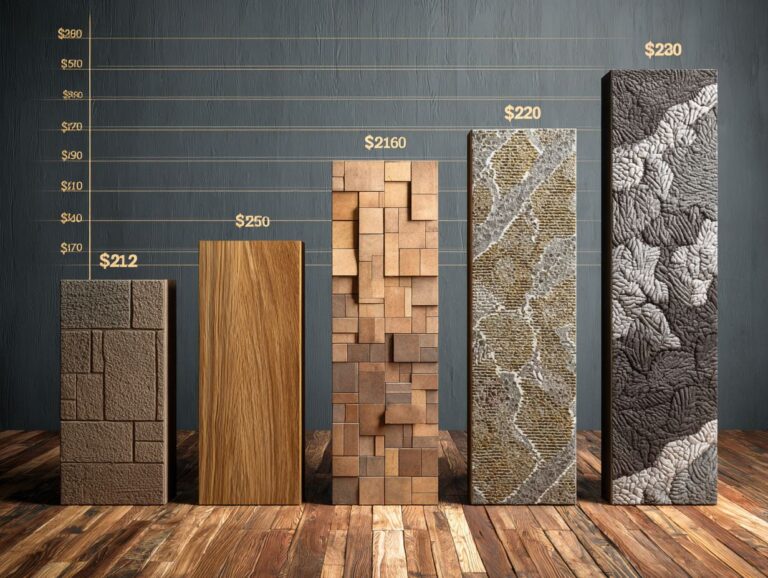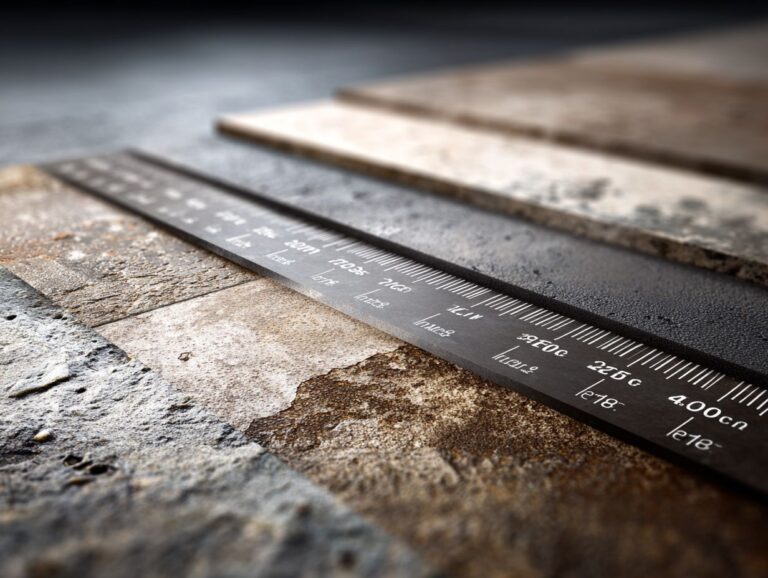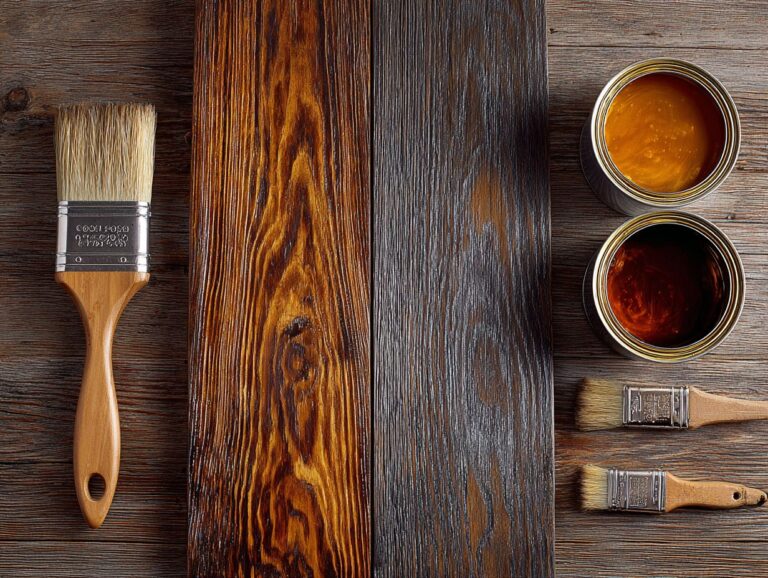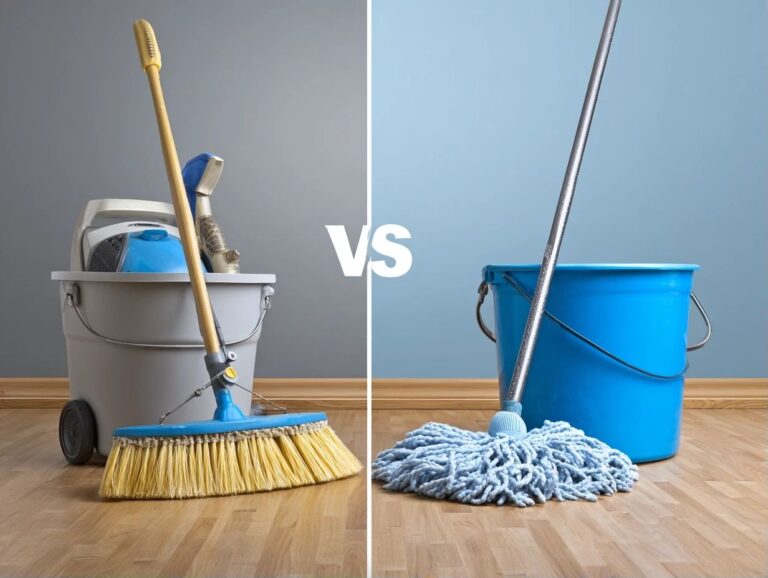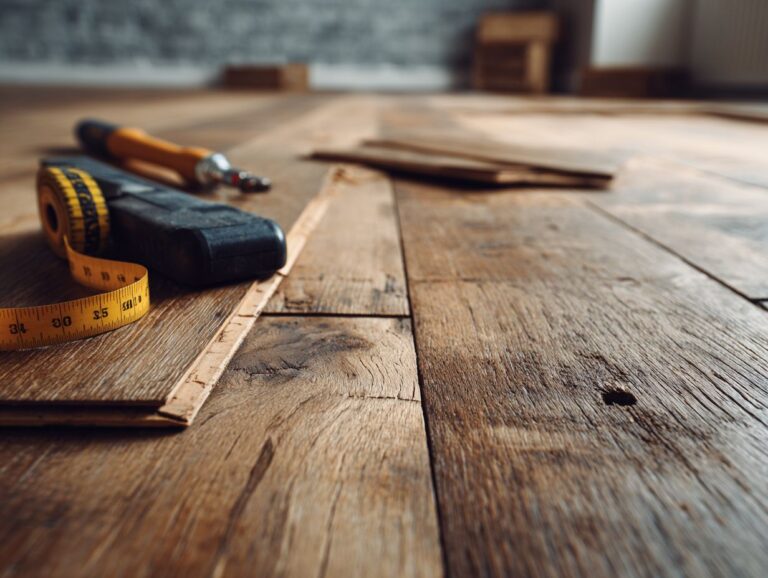Historic Floor Restoration – Preserving Character
Contents
- Introduction to Historic Floor Restoration
- Types of Historic Flooring
- Assessment of Historical Floors
- Restoration Techniques
- Preservation Best Practices
- Case Studies of Successful Restorations
- Historic Floor Restoration Data
- Challenges in Floor Restoration
- Frequently Asked Questions
- What is historic floor restoration?
- Why is it important to preserve the character of historic floors?
- What are some common techniques used in historic floor restoration?
- Can historic floor restoration be done on any type of flooring?
- What are the benefits of hiring a professional for historic floor restoration?
- How can I maintain the character and integrity of my restored historic floors?
Introduction to Historic Floor Restoration
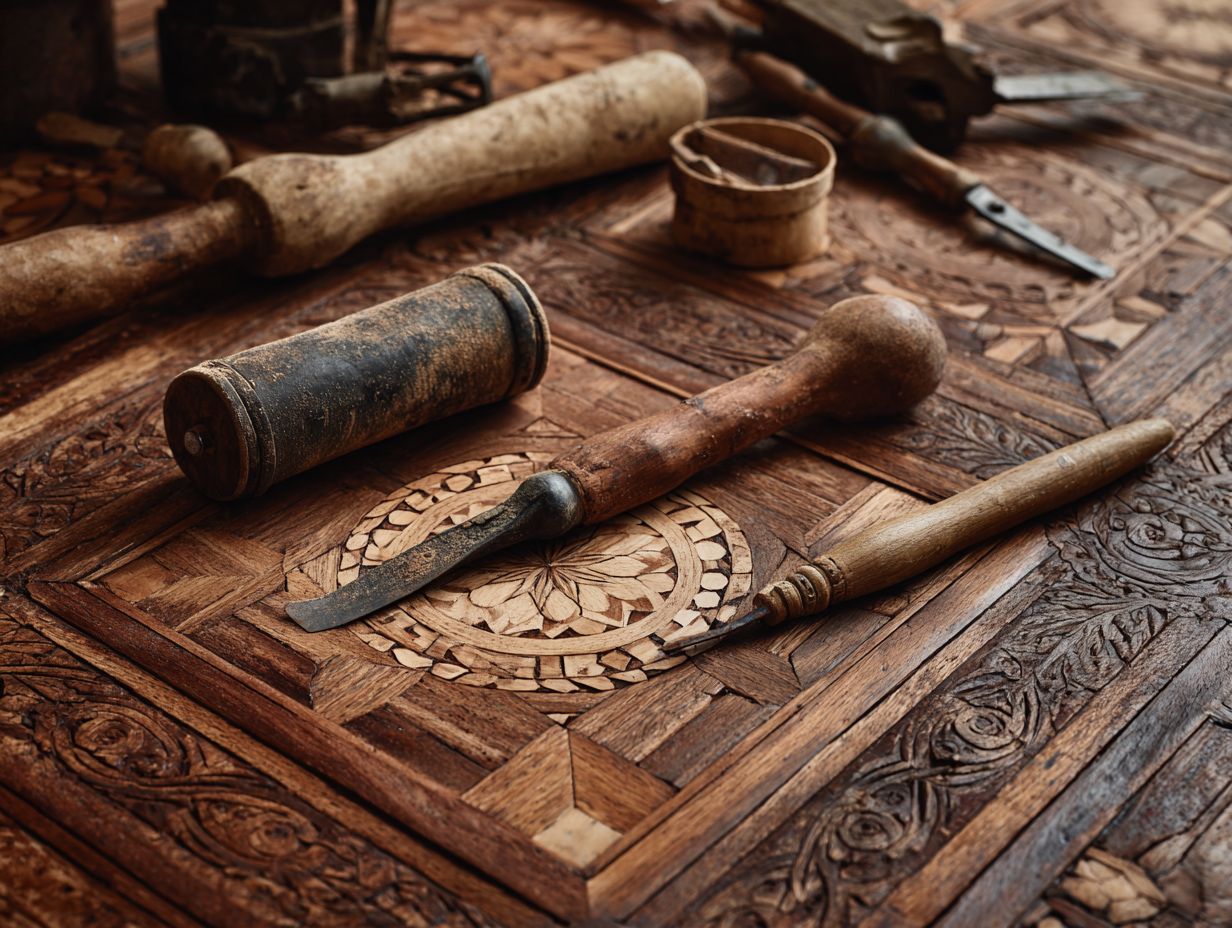
Key Takeaways:
Importance of Preserving Character
Keeping the original look of old floors keeps the true history of homes intact, which attracts potential buyers.
Renovated historic floors can greatly increase a property’s market value, with studies showing rises of up to 15%. Techniques such as refinishing with natural oils or using period-appropriate materials like reclaimed wood are effective in maintaining authenticity.
For instance, homeowners investing in proper restoration, including thorough cleaning and expert sanding, often see greater buyer interest. Using modern underfloor heating can make your home more comfortable and keep its appearance, enhancing its appeal and worth.
Overview of Historic Flooring Materials
Older houses have various flooring materials. Colonial homes usually have American chestnut floors, while Victorian buildings often have heart pine.
You might find oak floors in Arts and Crafts homes, recognized for their strength and distinctive grain patterns.
Restoration of these materials often requires matching finishes; for example, chestnut typically needs a natural oil finish to highlight its warmth.
Heart pine is a strong wood that does not warp easily. You have to sand and refinish it every 20-30 years to maintain its appearance.
When restoring, use techniques from the same time period to get an accurate historical result. Worth exploring: Reclaimed Wood Flooring – Sourcing, Costs & Installation
Types of Historic Flooring
Old floors are made in different ways, and each type needs particular methods to keep them in good condition.
Wooden Floors
Wooden floors, especially those with detailed patterns like herringbone and parquet, are very common in old homes.
Restoring these floors requires a delicate approach. Start with hand sanding in areas with delicate patterns, using 220-grit sandpaper to avoid damaging the wood.
An orbital sander can be used for larger, flat areas, ensuring evenness without excessive wear. After sanding, clean the surface thoroughly.
For the finish, a high-quality polyurethane is essential; consider water-based options for a clearer look. Tools like a foam applicator brush help achieve a smooth application, preserving the beauty of the original wood while providing protection against wear.
Tile and Stone Floors
Tile and stone floors, often found in Colonial and Craftsman homes, have particular problems, mainly concerning water damage and durability.
- To repair the floors, begin by choosing suitable materials like ceramic tiles or slate that match the home’s design.
- Use specialized restoration techniques like deep cleaning with a pH-neutral cleaner to remove dirt and grime.
- Next, apply a high-quality sealer to protect against moisture, especially in kitchens and bathrooms.
- When grouting, choose flexible grout to allow for slight movements without cracking.
- Always check and assess the foundation’s strength and stability to avoid problems later, making sure that the repair lasts and looks good.
Carpet and Textile Floors
Carpet and textile floors add warmth and comfort but require careful cleaning and repair to maintain their historical context.
To clean textile floors effectively, start with a vacuum to remove loose dirt and debris. For tougher stains, try eco-friendly options like mixing white vinegar with water; this mix cleans and removes odors.
Assess wear and tear by checking for frayed edges or fading colors-addressing these issues early can prevent further damage. Use a fabric repair kit for small repairs or consult a professional for extensive damage.
Regularly rotate your rugs to promote even wear, helping to maintain their integrity over time.
Assessment of Historical Floors
Carefully examining old floors is important for choosing the right methods to keep their worth.
Identifying Original Materials
Identifying original materials is essential, as it influences restoration choices and strategies, impacting the overall historical authenticity.
To correctly identify original materials, start by looking at them in person, paying attention to texture, color, and any visible workmanship.
Tools like a jeweler’s loupe can enlarge details, showing important information. Examining samples through methods like chemical analysis or using a microscope gives more information about what materials are made of.
For example, Fourier-transform infrared spectroscopy (FTIR) can identify organic substances to help with your restoration methods. By learning about these factors, you can select restoration techniques that keep the original piece intact and genuine. For those working with wooden surfaces, understanding the hardwood floor refinishing process can provide crucial insights into maintaining authenticity.
Evaluating Condition and Damage
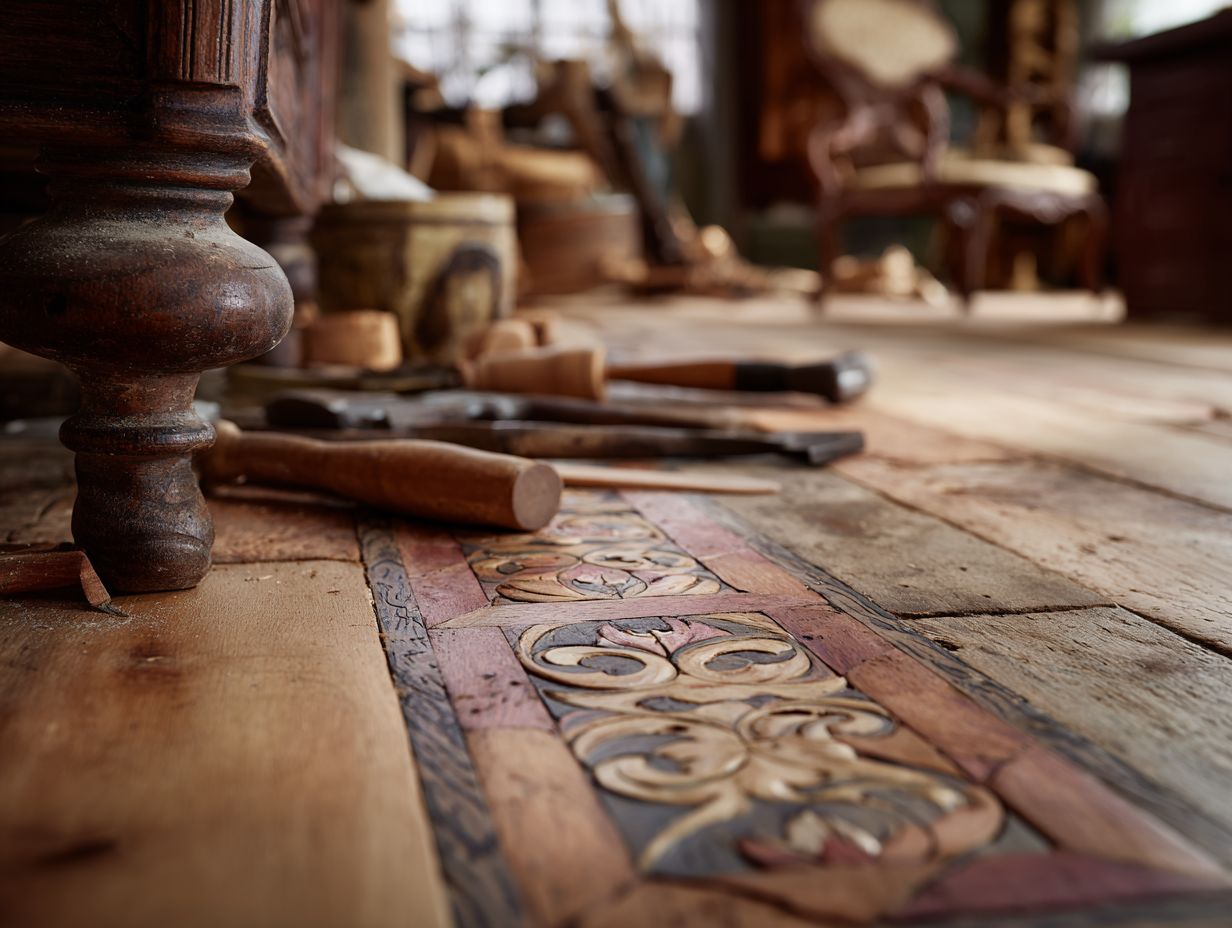
Checking the state of old flooring correctly can avoid expensive repair errors and help it last longer.
- Begin by checking for any signs of pest infestations, like droppings or damaged wood.
- Use a moisture meter to assess moisture levels, as excessive dampness can lead to mold and structural damage.
- Next, inspect for any visible cracks or shifts in the flooring that might indicate foundational issues.
- It’s wise to consult a structural engineer if significant concerns arise.
By methodically evaluating these aspects, you can make informed decisions on necessary repairs or restorations.
Understanding Historical Context
Knowing the history of a floor helps in making careful restoration choices that respect its original design.
Learning about particular times and styles can improve your restoration work a lot. Start by visiting local archives and libraries, where you can access old photographs and blueprints.
Preservation societies often provide resources or workshops focusing on regional styles, which can guide your design choices. Websites such as the National Trust and the Historic American Buildings Survey provide useful records.
Using these tools lets you understand the original materials and methods, ensuring your restoration honors history and maintains the building’s stability.
Restoration Techniques
Proper restoration methods are essential for making old floors look new and making sure they last.
Cleaning and Maintenance
Regular cleaning and maintenance techniques can significantly extend the life of historic floors, preventing deterioration from common issues.
To maintain historic floors effectively, start with eco-friendly cleaners like vinegar and water for regular dusting. For deeper cleaning, consider using a pH-neutral wood floor cleaner.
Establish a maintenance schedule:
- Weekly dusting,
- Monthly deep cleaning,
- Annual professional assessments.
Safeguard against scratches by placing felt pads under furniture and ensuring a no-shoes policy indoors. By implementing these steps, you can preserve the beauty and integrity of your historic floors for years to come.
Repairing Damaged Areas
Repairing damaged spots quickly with the right methods can stop more damage and keep the floor’s historical value.
For hardwood repairs, using matching wood planks is essential. Cut out the damaged section and fit a new plank, ensuring it’s seamlessly stained to match.
For tile, consider using an epoxy filler that closely matches the original color. Apply the epoxy, then use a damp sponge to carefully smooth the surface.
When dealing with textiles, patching with fabric from the same era can preserve the aesthetic. Blend the edges with fabric paint for a uniform appearance. Each method fixes the issue and keeps the appearance consistent.
Reinforcing Structural Integrity
It’s important to reinforce the structure when repairing old floors to keep them strong and safe.
- Start with a professional assessment to identify weaknesses, such as broken joists or sagging beams.
Common reinforcement techniques include installing additional support beams or brackets beneath the floor. For example, using steel lally columns can effectively support weight and improve stability.
Make sure all joists are firmly attached; using joist hangers can make the floor structure stronger and safer.
By addressing these issues early on, you can preserve the charm of historic woodwork while safeguarding the building’s overall integrity.
Preservation Best Practices
Using the best preservation methods can greatly increase the lifespan and genuine appearance of historic floors.
Using Authentic Materials
Using real materials, like reclaimed wood, is important for keeping the historical look of restored floors.
- To find reclaimed wood, visit nearby salvage yards or look online at places like Reclaimed Wood Exchange and Craigslist.
When restoring, opt for eco-friendly adhesives like Titebond III or Gorilla Glue Wood which are low in VOCs, ensuring a safer indoor environment.
For finishes, consider using natural oils like linseed or tung oil; they soak into the wood better and highlight its natural look while being good for the environment.
This mix of sourcing and materials honors the past and promotes eco-friendly methods.
Adhering to Preservation Guidelines
Sticking to known preservation rules helps make sure that renovation work keeps the old look of historic floors.
It is essential to refer to guidelines from organizations like the National Park Service, which emphasize techniques such as using appropriate materials and methods during restoration.
For instance, avoid sanding original wood floors, as this can diminish their historical value; instead, consider gentle cleaning methods. If reconstruction is necessary, use period-appropriate wood type to maintain authenticity.
Ignoring these rules can result in fines, loss of funding, or damage to the historical character of the property, which can reduce its worth and attractiveness.
Case Studies of Successful Restorations
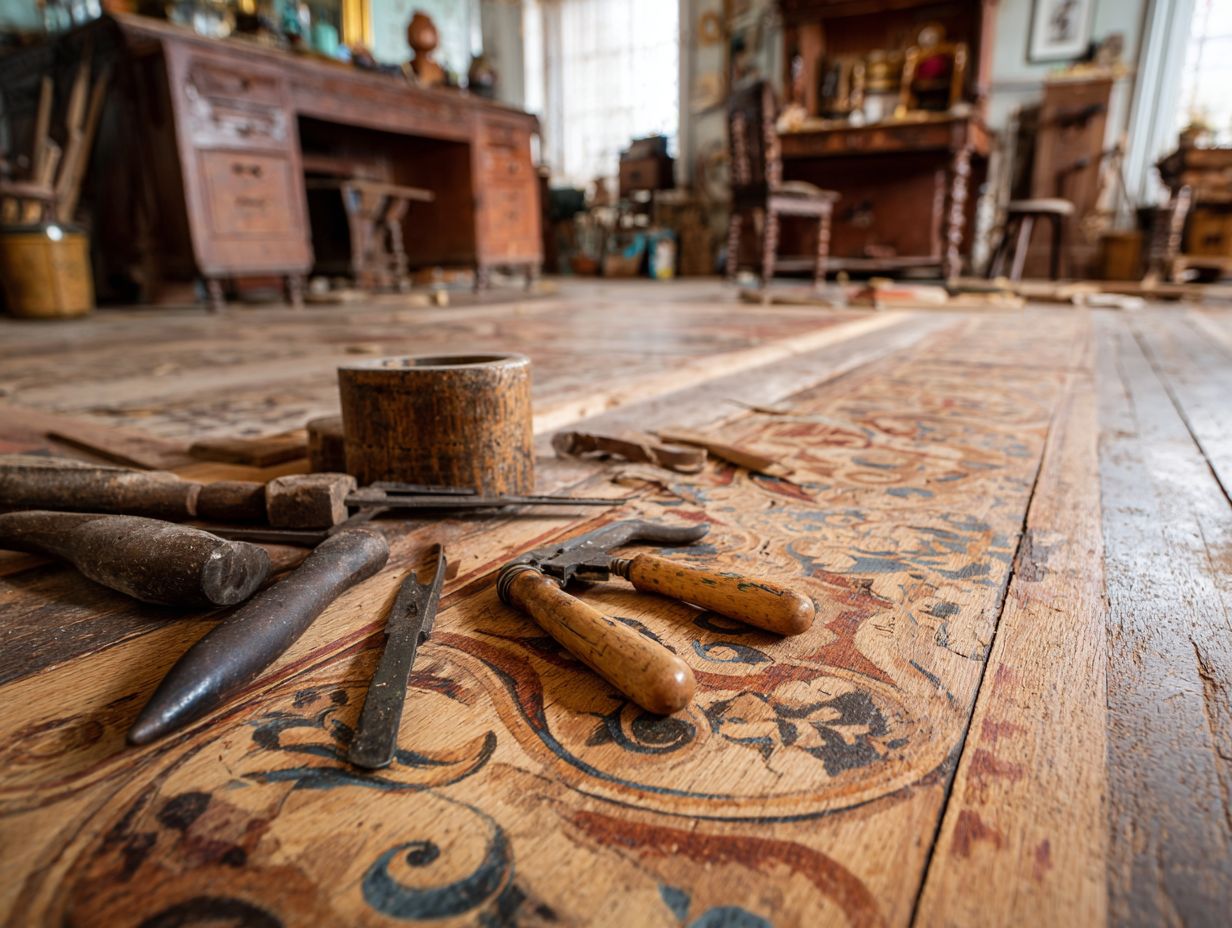
Looking at examples of successful restorations can offer helpful information and ideas for later projects.
Historic Floor Restoration Data
Historic Floor Restoration Data
Antique Hardwood Floor Restoration: Restoration Benefits
Antique Hardwood Floor Restoration: Challenges in Restoration
Antique Hardwood Floor Restoration: Restoration Techniques
The data from Historic Floor Restoration gives a detailed overview of the advantages, difficulties, and methods used in restoring old hardwood floors. This process brings back the look and usefulness of floors while making them last longer, helping to keep them in good condition for years to come.
Restoration Benefits highlight the many benefits of bringing back the original beauty of old hardwood floors. The restoration process can make things last longer by 100% making these floors stronger and more durable. Fixing up floors can raise their worth in the market by 75%, which is a strategic advantage for homeowners and historical sites. Environmental sustainability, rated at 80%, is another key benefit, as restoration reduces the need for new materials, conserving resources and minimizing waste. The restoration maintains 95% historical accuracy, preserving the cultural heritage embedded in these floors.
- Challenges in Restoration highlight the complexities involved. Maintaining historical accuracy stands at 85% “”, reflecting the detailed effort needed to maintain authenticity. Matching materials is another challenge, rated at 90%, as finding materials from the right time period is key to keeping the authentic appearance. Delicate handling, at 70% “”, emphasizes the need for experienced workers to keep the floor in good shape during repairs.
Restoration Techniques provide information on ways to improve the recovery process. Dust-free sanding leads the way with an effectiveness rating of 98%, ensuring a clean process that preserves air quality. Organic oiling at 92% provides a natural finish, enhancing wood grain while being environmentally friendly. Traditional waxing is valued at 89%, offering a classic sheen that protects the surface. Hand scraping, rated at 85%, is a careful method that keeps the floor’s texture and original look. Finally, natural stains at 88% improve the color without losing the wood’s natural look.
In summary, antique hardwood floor restoration is a blend of preserving history while embracing modern techniques and sustainability. The information shows that the restoration can improve strength, worth, and historical precision, even with natural difficulties. Using practical methods, restorers can produce results that respect history and protect what lies ahead.
Historic Homes
Fixing up Victorian homes, with their detailed woodwork and old hardwood floors, highlights the mix of genuine history and present-day practicality.
In one notable project, a homeowner tackled the challenge of a dilapidated Victorian built in 1890. Techniques such as stripping and sanding the original woodwork revealed stunning details, while modern insulation was discreetly added to improve energy efficiency.
Working with a history specialist helped us follow local regulations, ensuring the restoration stayed true to its original form. The result was impressive: original features like stained glass windows were carefully kept, creating a pleasing mix of history and comfort.
Photos taken before and after show the change from an empty building to a lively family home.
Public Buildings
Public building restorations often involve significant challenges due to the scale and historical regulations, but offer rewarding outcomes.
One notable example is the restoration of the historic City Hall in Boston. This project involved cooperation among building designers, conservation specialists, and local government officials.
The team used laser scanning to accurately capture the building’s details and chose materials such as limestone and brick to keep the building strong. Modern upgrades included energy-efficient systems, enhancing usability without compromising aesthetics.
Including the community in the process gained support, ensuring the building stays a key public area while respecting its historical significance.
Commercial Spaces
Restoring historic commercial spaces requires a unique approach to balance operational needs with preservation techniques.
A prime example is the renovation of the Pearl Brewery in San Antonio, Texas. The developers kept important design elements, like the original brick exterior and wooden beams, while adding modern features such as energy-saving heating and cooling systems.
They hired experienced workers to accurately copy historical elements and use materials appropriate for that time. They involved local historians to guide the preservation process, ensuring that the space remains true to its roots while catering to contemporary business functions.
This method brought new life to the area and drew businesses and visitors, showing how history and modern features can work well together.
Challenges in Floor Restoration
Bringing old floors back to their original look requires addressing different challenges, like meeting current demands while preserving their historical appeal and finding experienced workers.
Balancing Modern Needs with Historical Integrity
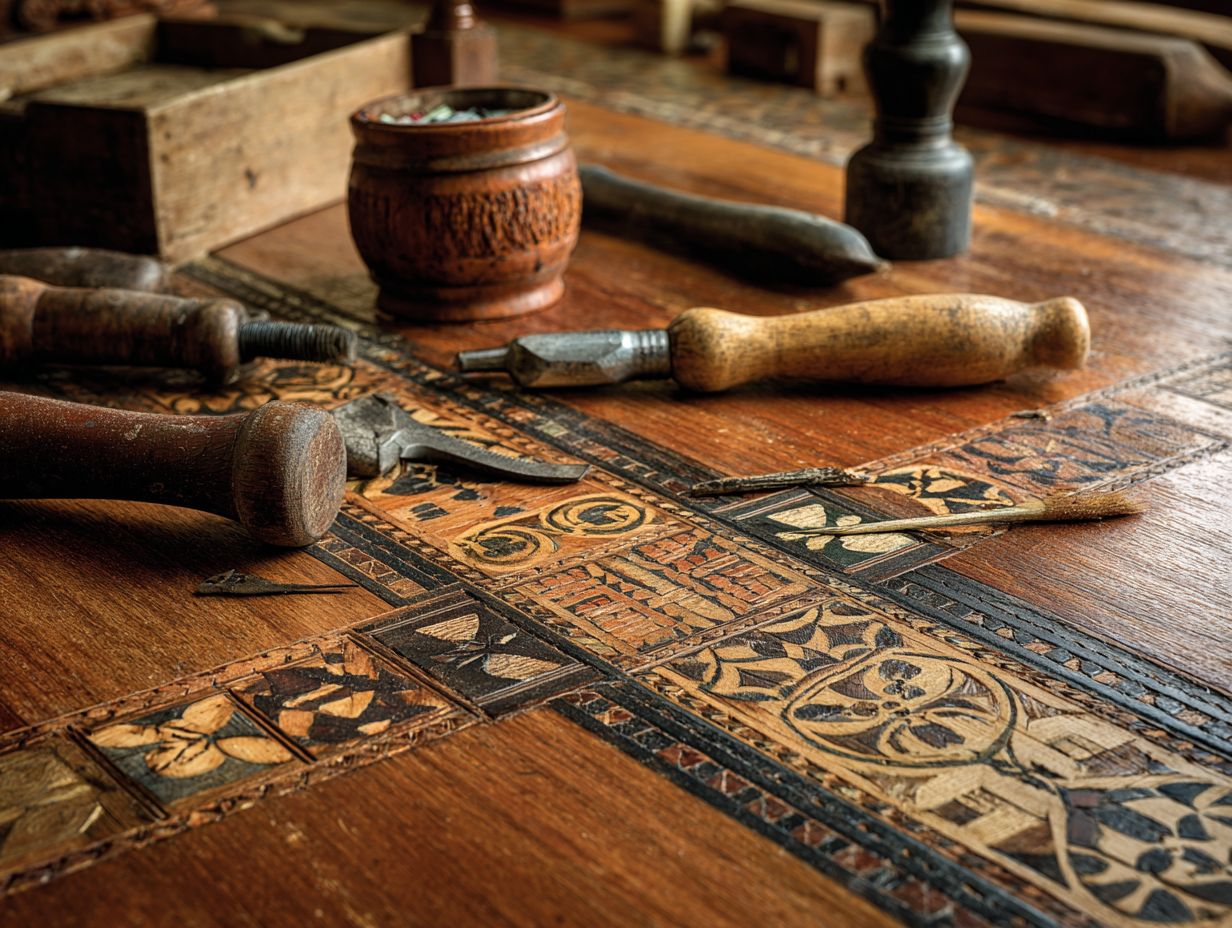
Finding the right balance between modern usability and historical authenticity is a primary challenge in floor restoration projects.
To address this, consult preservation experts who can assess both structural integrity and historical significance.
Use modern materials like stabilized wood or eco-friendly finishes to comply with safety rules while preserving the original look. For example, using water-based sealants increases durability and works well with traditional designs.
Make sure to document the restoration methods and materials used. This way, those who work on it later will understand the choices made.
By blending expert advice with thoughtful material selection, you can create a restored space that honors its past while serving modern needs.
Finding Skilled Craftsmen
Finding experienced workers who specialize in restoring historic sites can be challenging, but it’s important for achieving good results.
Begin your search by consulting regional trade associations, such as the National Trust for Historic Preservation, which often list qualified professionals.
Local preservation groups frequently have recommendations and can guide you to artisans familiar with specific techniques and materials. Make sure to check references and look at previous work to confirm qualifications. A visit to the site can show the quality of the workmanship.
For further assurance, look for credentials from organizations like the American Institute for Conservation, which indicate a commitment to heritage preservation standards.
Frequently Asked Questions
What is historic floor restoration?
Historic floor restoration is the process of repairing and restoring old or antique floors to their original condition. This can include cleaning, repairing, and refinishing to preserve the character and historical value of the flooring.
Why is it important to preserve the character of historic floors?
Old floors often have important cultural, artistic, and building significance. Keeping their character keeps the original look and records and respects the history and skill involved in making them.
What are some common techniques used in historic floor restoration?
Some common techniques used in historic floor restoration include sanding, refinishing, patching or replacing damaged boards, and using traditional materials and methods to maintain the authenticity of the flooring.
Can historic floor restoration be done on any type of flooring?
Yes, historic floor restoration can be done on many types of flooring, including hardwood, tile, and stone. The method of restoration may vary depending on the type of flooring and its condition.
What are the benefits of hiring a professional for historic floor restoration?
A professional restoration specialist will have the skills and experience to check the floor’s condition and decide on the best steps to take. They have the right tools and materials and can make sure that the restoration keeps the flooring’s original look and historical importance.
How can I maintain the character and integrity of my restored historic floors?
To maintain the character and integrity of your restored historic floors, it is important to properly clean and maintain them according to the recommendations of your restoration specialist. This may include using specific cleaning products and techniques, avoiding excessive wear and tear, and addressing any issues or damage as soon as possible.
